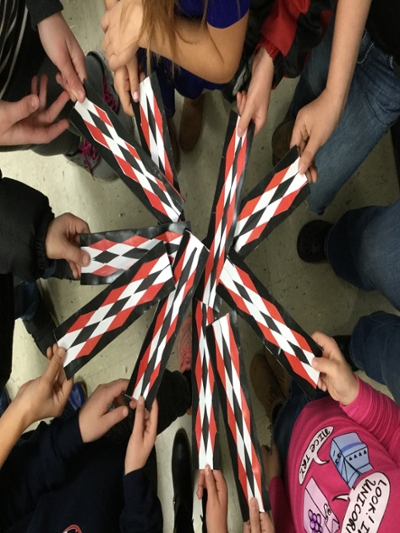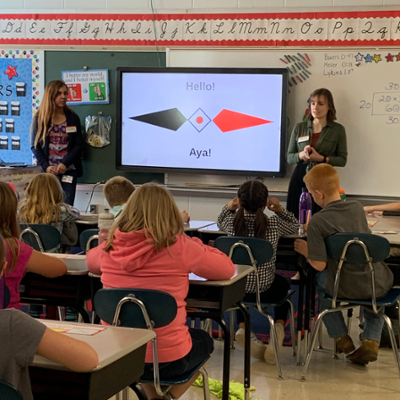
Myaamia culture and imagery to be part of the K-12 "Ohio as America" curriculum
Thousands of fourth graders will learn from the curriculum this fall
By Margo Kissell, university news and communications
The Myaamia Center, Miami University art education students taking ART 395 - Art Across the Curriculum and the Talawanda School District have collaborated the past three years on curriculum to help fourth graders learn about Myaamia culture and imagery.
The Myaamia Center, located on Miami’s Oxford campus, is the research arm for the Miami Tribe of Oklahoma.
Starting this fall, the two Myaamia culture and imagery lessons will become part of the K-12 Ohio as America curriculum. The Ohio as America resource, provided by the Ohio History Connection, was used by more than 20,000 students in 91 school districts last year. Private and parochial schools, as well as home-school educators, also use it, said Carla Mello, department manager of school and teacher support for the Columbus-based Ohio History Connection.
“Our partnership with the Myaamia Center and Miami University has been a vital step into creating educational content that provides the perspectives of communities and cultures that have been historically marginalized by traditional textbooks and resources,” Mello said.
Neepwaantiinki: Myaamia word meaning “learning from each other”

Miami art education majors Cas Napier, left, and Zania Hasty introduce Myaamia culture and imagery in a Talawanda fourth-grade classroom in October 2019 (photo courtesy of Stephanie Danker).
Stephanie Danker, associate professor of art education at Miami, and Kristina Fox, an education assistant at the Myaamia Center, will lead professional development on the Ohio as America curriculum later this month for more than 100 participants. Most are Ohio teachers.
Kara Strass, director of Miami Tribe Relations for the Myaamia Center, credited Danker with wanting to focus her ART 395 class around learning to teach about art that comes from cultures other than one’s own. Danker came up with the idea after her first of four trips to the Miami Tribe’s Winter Gathering cultural celebration in Miami, Oklahoma.
Myaamia Center staff conduct in-depth lessons with the art education students each year so they have a good understanding of Myaamia imagery and culture when they teach about it.
“This work is the heart of my research and teaching,” Danker said. “I am so proud of our students’ dedication to social justice,” Danker said. “We value the relationship with friends and colleagues from the Myaamia Center. They have taught us what Neepwaantiinki can mean.”
Neepwaantiinki is a Myaamia word meaning “learning from each other.”
Myaamia Center director Daryl Baldwin called the Art Across the Curriculum class project “a nice example of culturally relevant teaching that draws on the Myaamia Center’s interdisciplinary research and scholarship to create a path of learning and sharing among tribal scholars, art education majors here at Miami and fourth graders from the local school district.”
Fourth-grade teacher calls collaboration a gift to students

Talawanda fourth graders show off their ribbonwork bookmarks (photo by Maria Jose DeSantiago Galan).
All of the Miami art education majors who will teach the Myaamia lessons in Talawanda schools this fall will attend the Ohio as America professional development session, Danker said. The lessons are tailored to meet social studies and art standards.
They are preparing for digital delivery of the lessons due to the possibility of remote circumstances in local schools, but Danker stressed the format will not diminish the relevance or impact of the lessons.
Barbara Hamilton, a fourth-grade teacher at Kramer Elementary School, said the collaboration with the Myaamia Center staff and Danker's class has been a gift to her young students.
“Our students learned some of the rich history of the Myaamia people and were invited to see history from a different perspective than they'd previously considered,” she said.
The children learned some words of the Myaamia language and made paper bookmarks which simulated a traditional Myaamia ribbonwork pattern. They learned that only Myaamia artists make ribbonwork and the concept of appropriation versus appreciation. Hamilton said those activities brought the Myaamia culture to life.
“It was a special moment to be with my students when they realized that Myaamia people are a living people and that the culture is so much more than an excerpt in a history book,” she said.
Creating culturally sensitive lesson plans
Maria Jose DeSantiago Galan, a senior art education major from West Chester, taught the fourth-grade lessons at Maude Marshall Elementary School in Oxford in fall 2018. She was one of four Miami art education students who traveled by bus that following January to the Tribe’s Winter Gathering.
DeSantiago Galan — who will be student teaching at Fairfield High School and Fairfield South Elementary School this fall — said the experience “really broke down the process of creating culturally sensitive lesson plans through action-based research and community engagement.”
The art education students worked directly with Miami Tribe members through the Myaamia Center. DeSantiago Galan enjoyed the culture and imagery workshop where they learned firsthand about the Miami Tribe’s heritage and artistic expression.
Fourth graders learn about the forced relocation of the Tribe as well as the ongoing revitalization of the Myaamia language being led by the Myaamia Center.
Strass said fourth grade is when Ohio students learn about Native Americans, but they tend to only learn about Native people as a part of history.
“I hope that through these lessons, the fourth-grade students learn that Native people are living, vibrant people who are connected to their communities and cultures and land, including here in Ohio."
Want to read more stories like this? Follow us on Twitter @MiamiOHNews.
